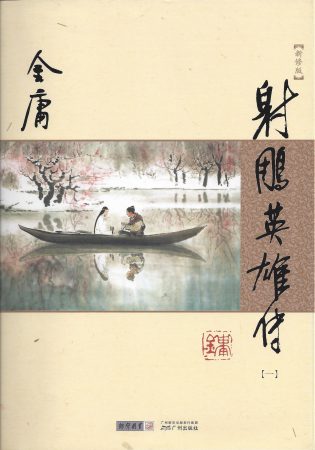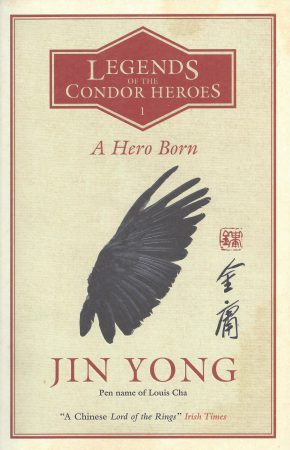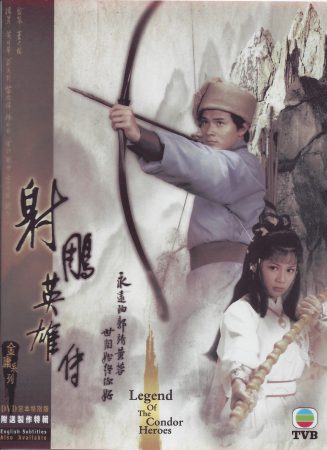
Original book cover of Legends of the Condor Heroes (Guangzhou Publishing House)
When I agreed to write a book review of the first-ever English translation of Legends of the Condor Heroes, I had no idea I would be opening Pandora’s box of not only nostalgia, but also questions about translation and language.
Condor Heroes is a massive 12-volume trilogy written in Chinese by the late Dr. Louis Cha, under the pen name Jin Yong (金庸).
First published in 1959, the original volumes didn’t have individual titles; they were merely numbered 1-12. Before that, the stories were originally published in his newspaper, Ming Pao, as a continuing fiction series—but that is a history lesson for another day.
The first volume has since been translated into English by Anna Holmwood and named A Hero Born. The added bonus of giving the translation an entirely new title is that it is easier to distinguish it as the English-language version.

Legends of the Condor Heroes – English translation (MacLehose Press)
Published in February 2018, Holmwood’s translation has been such a huge success that MacLehose Press plans to translate one volume each year, until the entire set is completed.
Gigi Chang is translating Volume Two, with the title, A Bond Undone. At the writing of this article, Amazon lists that the title will be available for purchase in late January 2019. Holmwood is editing that one, while translating Volume Three for its proposed February 2020 publication.
Knowing how different Chinese and English are, I wondered, “Will Holmwood’s translation be reliable? Can it recreate the effect of the Chinese original?”
For example, in A Hero Born, Lotus Huang and Guo Jing sneak into the Jin palace. Lotus injures a servant in order to coerce him into helping them get medicine from the royal pharmacy.
The servant is in tears from pain. Holmwood describes, “Snot bubbled in his nose.”
I did a double-take. Did Dr. Cha really mention a detail so funny, about the character having snot? And did that snot really bubble from the servant’s nose?
This called for a closer look.
The art of translation
“There’s no one way to translate,” says Nick Stember, a translator of Chinese comics and science fiction (and the former translation editor for Ricepaper). Stember cautions me against making snap judgements when assessing Holmwood’s work. “There’s no such thing as a perfect translation. It’s not the English translation; it’s a translation. It’s like in jazz music, like an arrangement.”
Adding to the confusion, the Condor Heroes trilogy exists in three different editions: 1959, 1976, and 2003. Each edition features significant revisions by Dr. Cha himself, including characters being edited out entirely, when he later decided them to be superfluous. The 2003 edition in particular was not necessarily well-received by all fans; some still prefer the earlier versions.
Moreover, Condor Heroes was banned in Taiwan until 1979, so underground versions were produced that barely resembled the originals.
With three different versions of the “original” Condor Heroes, unauthorized versions floating around Taiwan, as well as numerous TV and film adaptations—is there even an “original” Condor Heroes anymore to begin with?
Stember also pointed out that the differences between Chinese and English make translation between the two languages especially difficult.
“Chinese has no verb tenses, no subject, and has lots of freedom,” he says. “English has more synonyms, more words. Chinese is more concise and the same adjectives can come up again. But translated directly into English, it can be repetitive. In English it is considered bad writing if you use the same adjectives.”
Stember gives one other tip on how to assess a translation. “We often talk about what’s been ‘lost in translation,’ but rarely talk about what is gained in translation,” he says. “Humour is most cultural-specific. If a translator can successfully translate the humour, then it’s a good translation.”
By taking on such an ambitious project, of such a famous Chinese literary work, Anna Holmwood is surely setting herself up to be a lightning rod for criticism. What would compel her to take on such a crazy task?
“The folly of youth,” she says with a laugh.
From Anna
Anna Holmwood answers my Skype call from her home in Malmö, Sweden. We spoke twice last year, in August and in September.
“The figure of ‘translator’ is very vulnerable,” she says. “They mediate between the culture of those who can and can’t read the original language. You’re their only access. People can resent you.”
Even more so when the figure is Jin Yong and his legions of fans.
Holmwood, who has a master’s degree in modern Chinese studies from Oxford University, began working as a professional translator in 2010. Two years into her career, she noticed that Legend of the Condor Heroes hadn’t been translated in English before. With the debut of A Hero Born in February 2018, she is the first person in 59 years to begin doing so.
“I thought it would be career-defining,” says Holmwood. She was right.
Success of A Hero Born has “far exceeded expectations.” St. Martin’s Press has purchased the US rights for the first four volumes and will begin publishing a US version of A Hero Born in 2019.
Given that the 2003 edition is a bit controversial among fans, I asked Holmwood why she chose that one. Her reason was simple: That was the edition requested by Dr. Cha’s representatives. Who can argue with that?
Holmwood completed the bulk of translating the 120,000 words of A Hero Born in 18 months, but in total, it took five years of behind-the-scenes work to bring it to publication.
And yes, there were times when she had doubts and worries about potential criticisms from Condor fans.
In times like these, Holmwood credits her Taiwanese husband, who previously worked in television, for his encouragement and support. “He said, ‘You can’t stop people from voicing their opinion. You have to believe in what you’re doing, and deal with the anxiety.’”

Legends of the Condor Heroes – DVD cover (TVB Jade)
The name controversies
The most hotly-debated topic online is Holmwood’s choices in translating names. Some allege her of being inconsistent.
Until Stember educated me on how to assess a translation, I also noticed the differences and questioned why Holmwood appeared to be inconsistent.
Some names were kept in their original pinyin, in Chinese order, with surname first (“Guo Jing”). Others were translated directly into English, with surname at the end (“Ironheart Yang”), while some were translated into a subsense (“Apothecary Huang”). And still others were changed entirely from their original Chinese (“Kholjin”, “Gallant Ouyang” and “Mercy Mu”).
[For readers who aren’t familiar with Condor Heroes, the actual names of Genghis Khan’s four sons were kept in their original form, whereas the daughter, Huazheng, was presented as a Chinese name. Huazheng was part of a fictionalized love triangle storyline among the hero, Guo Jing, and his true love, Huang Rong.]
For the character Huang Rong (黃蓉), I looked up “蓉” (“Rong”) in the Oxford Chinese Dictionary.
“‘Rong’ doesn’t translate into ‘Lotus,’” I say.
“There are some dictionaries which do,” says Holmwood. “More often it’s translated into ‘hibiscus,’ and less commonly as ‘lotus.’”
“Why did you change Huazheng (華箏) into Kholjin?” I ask. Kholjin is an entirely different name!
Holmwood explains that she researched Mongolian names and had found that Genghis Khan did have a daughter named Kholjin. She thought it would be more authentic to use an actual Mongolian name in the translation.
For the record, Holmwood does give detailed responses on why she made the name choices she did. However, given the limits of our interview time, I felt that I couldn’t do it justice, so I’ve abbreviated her actual response in this article.
[For readers who want to learn more about why Holmwood made some of her choices in name translations, the preface and appendix of A Hero Born gives some explanations.]
The other point that arises from our discussion is the fact that there is a dearth of Chinese-English dictionaries, compared to translation dictionaries of other languages. Ditto for the names of Genghis Khan’s daughters. Prior to our interview, I did attempt to research local resources, but couldn’t find any. My next step would have been to seek a university library and higher levels of help.
“I believe in the choices I made,” says Holmwood. “For me it was more about creating a feel across the whole text and take into the needs within the context of a paragraph. Do I go for something poetic, or something that is accurate? Sometimes poetic is more accurate in the context of literary translation than the ‘accurate’ translation.”
Good point. Holmwood changed the name of Guo Jing’s mother from Li Ping (李萍) to “Lily Li.” “萍” (“Ping”) actually translates into “Duckweed,” so hands down that Holmwood made the best decision in giving the hero’s mom a more palatable name as “Lily.”
“A translation is never finished,” says Holmwood. “In 10-15 years’ time, maybe someone will come up with an alternative translation of Condor Heroes.”
But until then, Holmwood’s is the only one.
Yes, the servant really did have snot
But it didn’t bubble.
In the Chinese text, the servant really does arrive with “汗氷、眼泪、鼻涕” (hànshuĭ, yănlèi, bítì): “sweat, tears, nose mucous.”
In English, “nose mucous” has a serious connotation, such as when speaking to a family physician. If you want to be funny, usually you will use the word “snot.”
Chinese only has “鼻涕” (bítì) for nose mucous and is neutral.
Using Stember’s tip as a guide, Holmwood did a great job. She did alter the translation, yes—but for the better, and she did it without altering the character of Dr. Cha’s text. Kind of like taking someone whose face is already beautiful and applying makeup skillfully on it.
I did some more spot checks. The original draft of this article featured more examples, but it began to read too much like an academic dissertation.
What I learned from this journey is that a good translation isn’t necessarily about a word-for-word, dictionary-like approach. That could get tedious, especially if the two languages have very different structures, such as Chinese and English .
What’s important is whether Holmwood can capture Dr. Cha’s talents as a writer: the unique personalities he forged in his characters, his wisdom of human psychology, and his sense of humour. I would say she did. And it looks like I’m not the only one who thinks so.
Most touching for Holmwood is when people of American-Chinese heritage let her know how happy they are that because of her, they can now read and enjoy the full text of Condor Heroes in English.
“That really moves me,” says Holmwood, “because I’m half-Swedish, so I know what it feels like to have two cultures that you are immersed in, but one you still don’t have full access to because you’re not a native speaker. Hearing that kind of feedback makes me feel like it’s all worthwhile.”
5 comments
“A translation is never finished,” says Holmwood. “In 10-15 years’ time, maybe someone will come up with an alternative translation of Condor Heroes.”
But until then, Holmwood’s is the only one”
It isnt the first:
http://www.wuxiasociety.com/the-legend-of-the-condor-heroes/
Well it seems that Holmwood is not really good at doing her research.
Also, I hope someone does come up with an alternate translation one day that treats the characters with respect and doesn’t butcher theit names with clowny adjectives. Shame on her for tarnishing Jin Yong’s hard work.
Anna Holmwood is full of crock. She complicates a whole host of names, and for what? What rule of translating novels states that you must translate ALL names to their literal meaning? Literally any other novel about any other ethnicity, be it Japanese, Korean, Indian, Middle Eastern, etc. has characters that get to keep their names intact in their respective languages. I was so excited for this book to come in the mail, thinking I’d get to read a well-done novel about the show I grew up watching in the 90’s, but the names make it impossible to enjoy. The names don’t add to anything and are even clunkier to read. Additionally, Holmwood contributes to the problematic mysticism/parodyism of Asian culture by reducing the characters to kistchy, almost gimmicky monikers. It is so difficult to feel immersed when you’re literally reading about someone named Browbeater Hou. *Browbeater*. Are you kidding me? If she really needed to, she could have given the translations of the names in some addendum elsewhere. Why why WHY would she do this??
Did Holmwood not have a Chinese native to consult in the course of this translation? Is she also tone-deaf to the fact that Asians are getting tired of all their representation being portrayed as exotic symbols in Western media? Sorry, but I just cannot condone this translation even though the rest of the story is translated nicely. Names are so important to the identity of characters, that I feel this affects the story quality to a point for me. Honestly wish this translation had been done by someone natively Chinese instead. Until she stops this ridiculous naming habit, Holmwood should just stick to Swedish works.
I have never read JinYong’s novel. But I did watch the entire TV series and speak fluent Mandarin and Cantonese. I too agree with A. PHAM the names are so integral to the ‘personification’ of the characters. And Holmwood’s inconsistent naming methods causes confusion and disconnect amongst all the characters. Names should have been kept as pronunciations instead of trying to interpret and give layered meanings to them. By this alone, I have put off reading this translation of the book.
I bought a set for my nephew, who is American-Born-Chinese. . He is NOT a fan of Harry Potter which is quite racist towards Asians. So I applaud Anna for a sincere attempt to bridge languages/cultures as different as Chinese and English.
Anna’s husband is Taiwanese, so she does have a free consultant who understands the historical context and nuance.
I grew up in Malaysia, speaking 3 languages and 4 dialects. I once attempted to translate and gave up after two chapters. It was that difficult, so many dimensions to consider..
Anna and her husband are making language kits for their boys. Bravo Anna!